Dimmers for LED lamps
Dimmers, specifically designed for LED lamps, are starting to appear on the market. I bought and tested two models: Legrand Etika 672219 and Schneider Blanca BLNSS04001.

Most LED lamps do not support brightness control, but there are also dimmable lamps, the brightness of which, in theory, can be adjusted with a conventional dimmer for incandescent lamps.
Many are faced with the fact that dimmable lamps work poorly: either they shine too brightly at the minimum level, or at some levels their light begins to shake, or they buzz when dimming, or they flash and flash at all. It turned out that almost every lamp model works in its own way with each dimmer model. The first reason for this is that conventional dimmers are not designed for LED lamps, many of them have a minimum load of 40-60 W and often this is less than the consumption of the entire chandelier with LED lamps.
')
Last year, I checked how ten different dimmers work with fifteen models of LED lamps ( habr.com/ru/company/lamptest/blog/430678 ). Only one dimmer out of ten worked flawlessly with all the lamps, but it was a radio-controlled dimmer specifically designed for LED lamps.
Among the hundreds of conventional dimmers with a spinning knob on sale, you can find several models designed for LED lamps. On their packages it is indicated that they work with LED lamps, but most sellers and online stores for illiteracy do not indicate this.
Such dimmers can be distinguished by several features:
Different lamps work differently when dimming on the leading and trailing edges. It so happens that when dimming on the leading edge of the lamp, it buzzes loudly, and there is almost no sound on the back. Others, when dimming on the back front, "go crazy" - they flash, blink. Third, when dimming on the leading edge, they glow too brightly even at the very minimum of dimming, and when dimming on the trailing edge, they can go out almost to zero. That is why the ability to switch the dimming method is important for LED lamps.
All the signs listed above have two dimmers that I found and bought for the experiment.

Legrand Etika 672219 costs 1475 rubles and you need to buy an additional frame for it. Schneider Blanca BLNSS040011 (the last figure means color) costs from 1,425 rubles and its frame is already included.
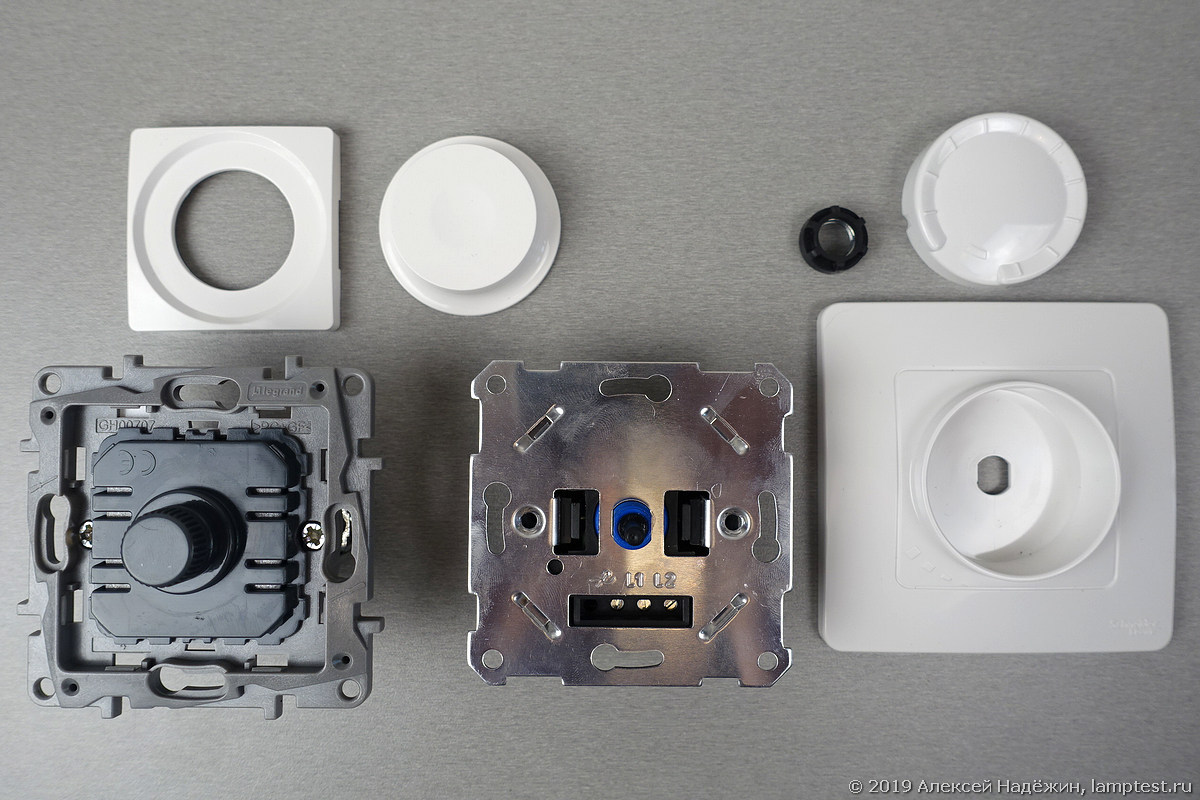
Legrand Etika 672219 can work with ordinary incandescent bulbs or halogen bulbs with a total power of up to 300 watts or dimmable LED bulbs from 5 to 75 watts (maximum 10 bulbs). It is controlled by an infinitely rotating knob-encoder (adjustment from minimum to maximum - 1.5-2 turns). Pressing the knob to turn the light on and off.
It is possible to connect additional control buttons with which you can both turn on and off the light (short press) and adjust its brightness (long press).
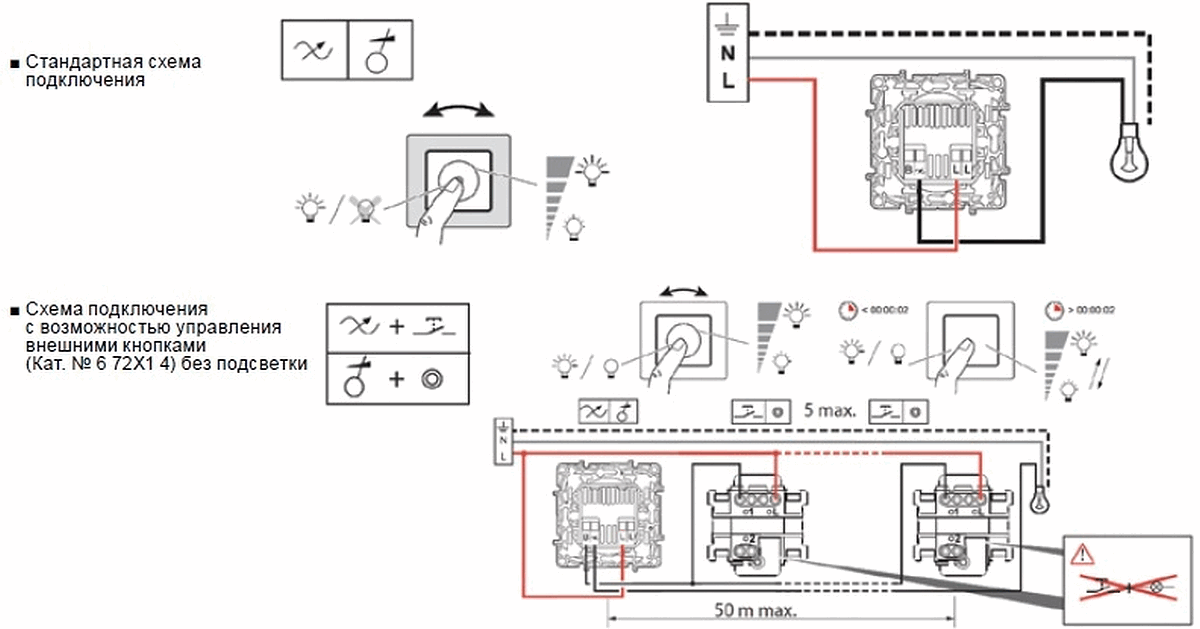
To connect the buttons there is an additional contact, two contacts L are interconnected.
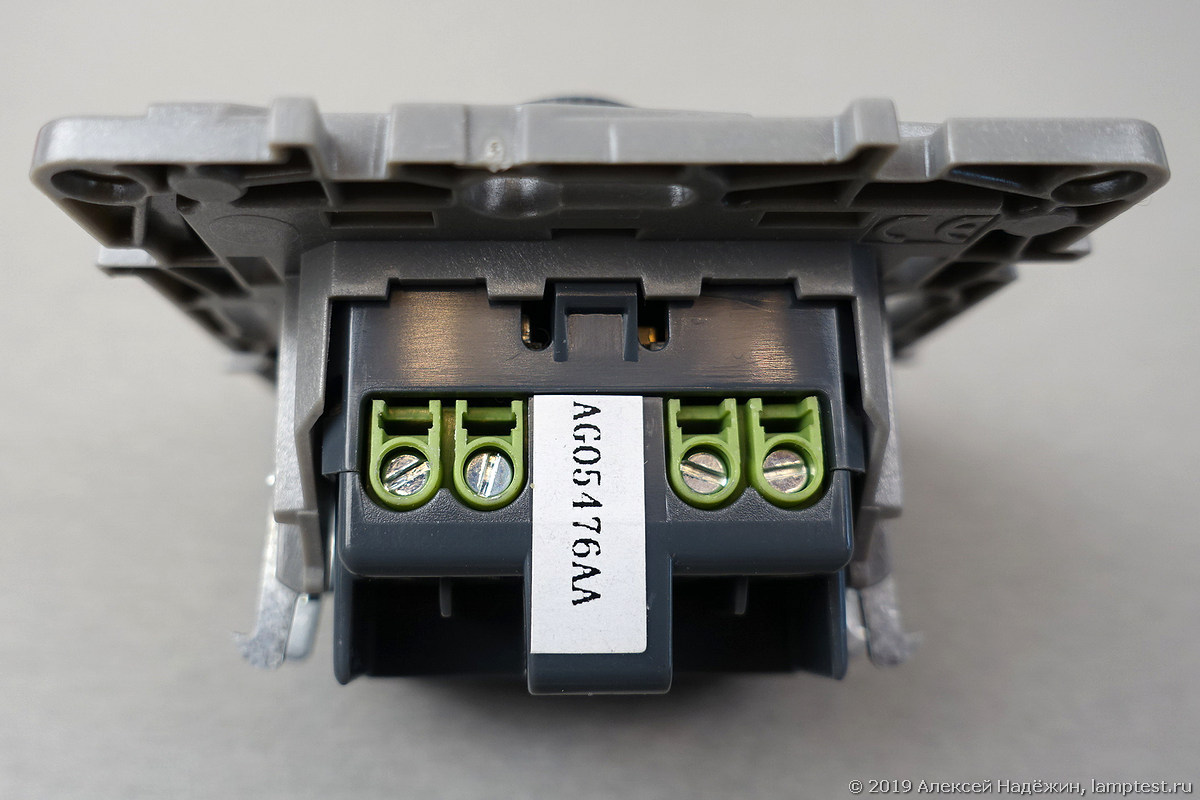
The dimming method is changed by a microswitch on the side wall.
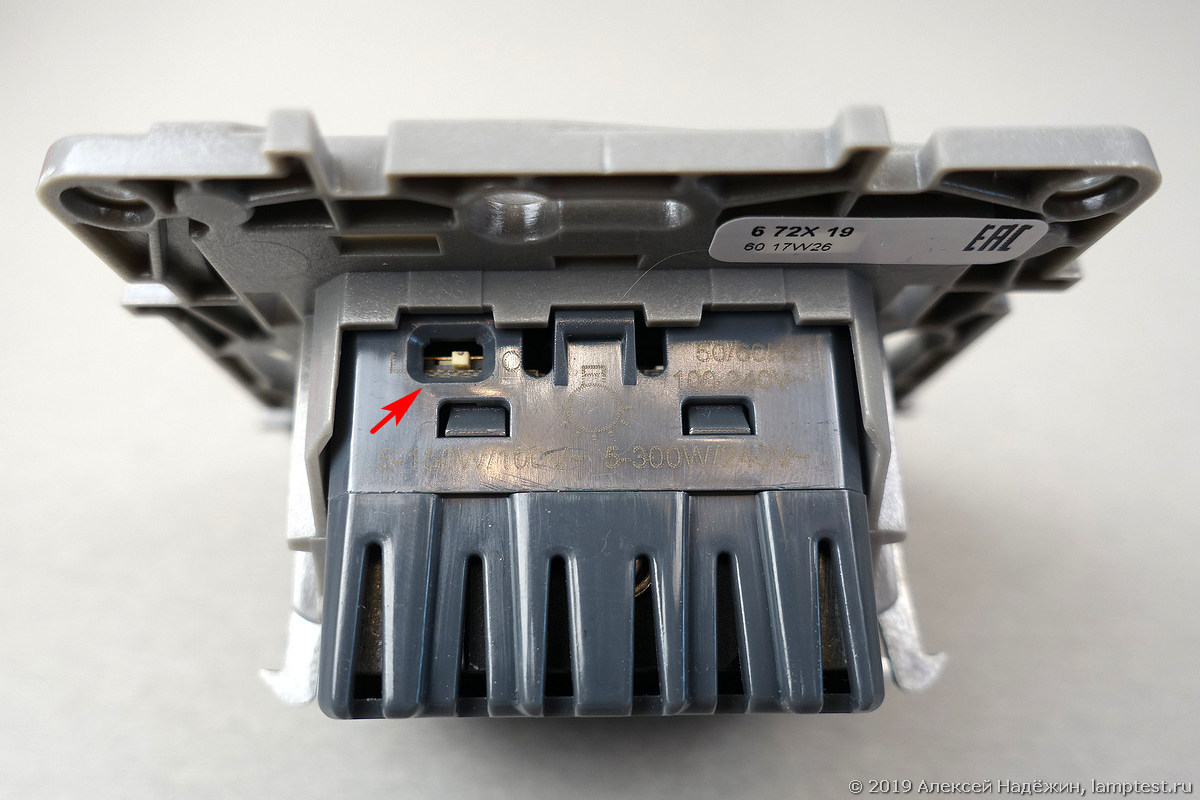
The minimum brightness level is adjusted after a long press on the handle.
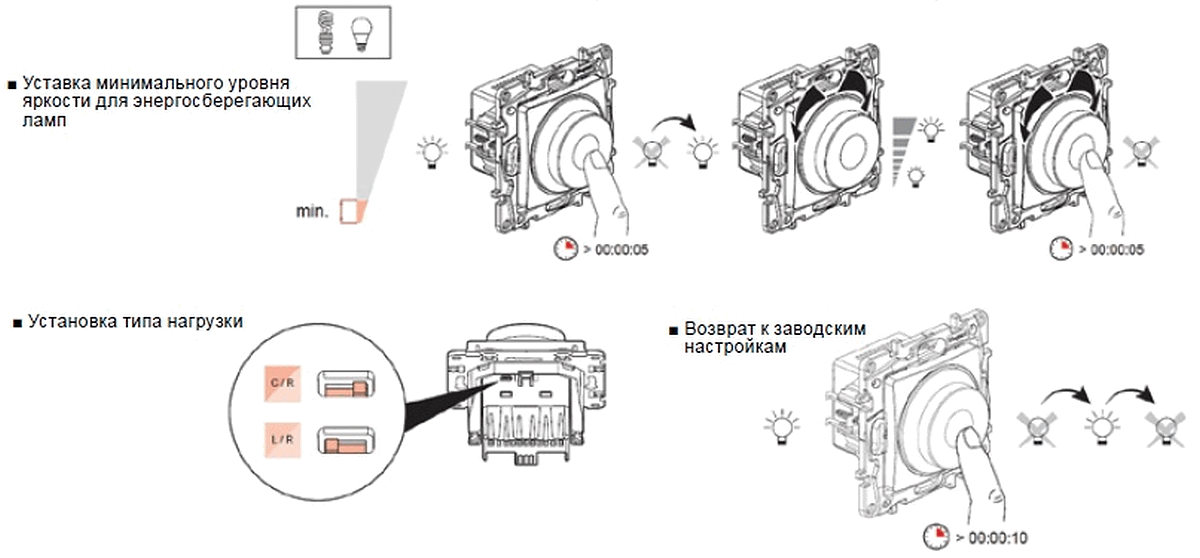
Dimmer remembers the state and when turned on sets the brightness that was before shutdown.
The Schneider Blanca BLNSS04001 works with incandescent and halogen lamps up to 400 watts or dimmable LED lamps from 5 to 150 watts. It is controlled by a 16-position step-encoder knob and an emphasis in the extreme positions, respectively, only 16 luminance levels are possible. Pressing the knob to turn the light on and off. The brightness level and the state (on or off) is remembered even when the electricity is turned off.
The dimmer has three contacts.

Two inputs L1 and L2 allow external control of the light to be realized: if a switch is connected to them, it will turn the light on and off (if the dimmer was turned on, when the switch is switched the light will turn off, if it is turned off, it will turn on). When this function is not needed, electricity can be connected to any of the inputs.

On the front panel there is a hole under which the service button is located.
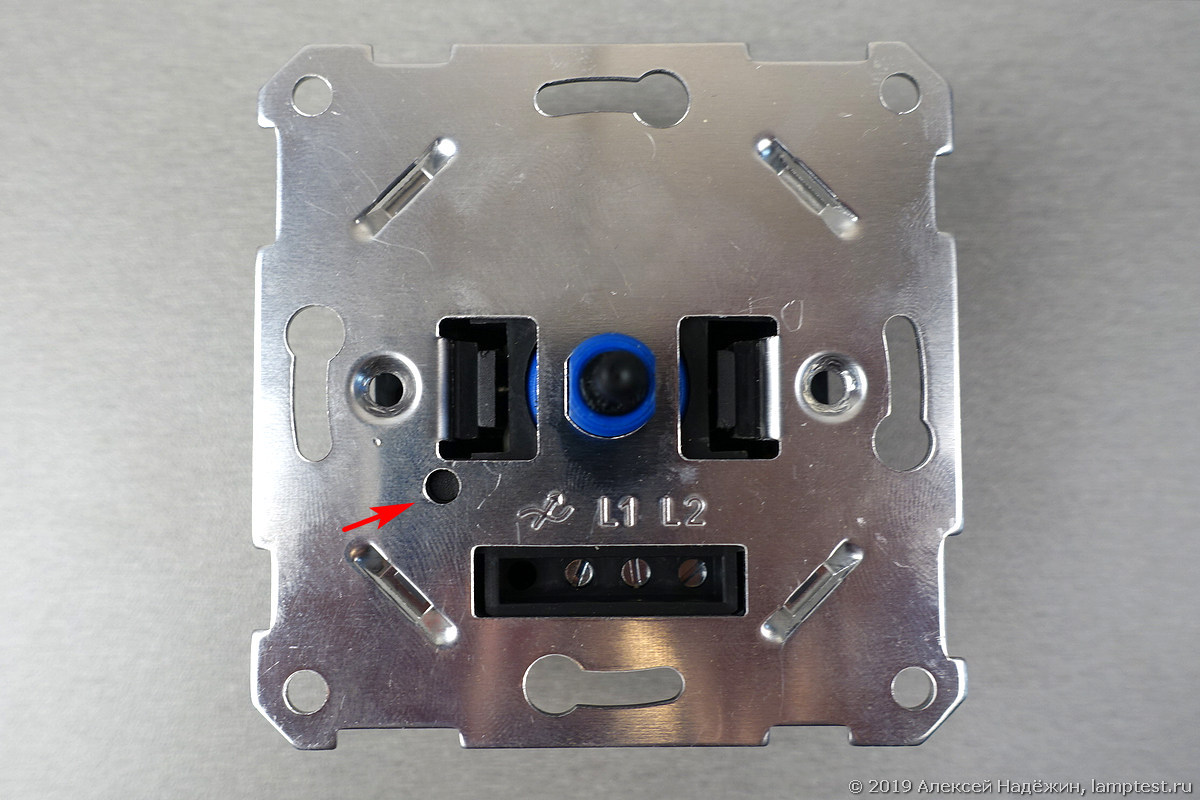
With this button and the main knob the minimum level of brightness is adjusted and the dimming method is selected.

Sometimes dimmable LED lamps behave differently when one or several lamps are connected to the dimmer, so I experienced dimmers with 4-6 lamps connected in parallel, because that is what will be in a real chandelier.
Both dimmers work quite well with different lamps and in one mode or another, each of them worked normally with each set of lamps. Due to the fact that the dimmers are switched on by a two-wire circuit, not all the lamps are lit at full brightness at the maximum adjustment (they give 95-99%, which is almost indistinguishable from the full brightness).
All lamps can reduce the brightness to levels less than 1% of the full brightness, but in some cases the lamps do not light up at such low brightness and after switching on you have to turn the knob to the right so that the lamps light up and then decrease the brightness, if necessary. However, you can set the minimum brightness at the level of 3-5%, at which the lamps are guaranteed to turn on (there are also those that turn on even at the level of 0.1%).
A strange thing happened to the Legrand dimmer. At first, it always turned on at 100% brightness and smoothly, for 5 seconds, reduced the brightness to the memorized one, and then suddenly stopped doing it and began to turn on immediately at the memorized brightness. Most likely, he has different switching modes, which are somehow tuned by the manipulations with the pen and clicks on it, but in the instructions there is not a word about it.
The oddities were with Schneider: the manual says that it switches the control method on the leading or trailing edge by long pressing the service button, and the light flashes once or twice. In fact, it turned out that the work on the leading edge is activated by long pressing the service button when the brightness is set to maximum (the light flashes three times). Work on the falling edge is activated by long pressing the service button when the brightness is not maximum (the light flashes once).
Pros dimmer Schneider Blanca BLNSS04001:
- Works with all LED lamps;
- It is convenient that the handle has extreme positions;
- To switch the type of regulation does not need to remove the dimmer from the wall;
- You can control the light with an external switch.
Cons dimmer Schneider Blanca BLNSS04001:
- For the settings you need to remove the front panel;
- Enough hard press.
The advantages of the Legrand Etika 672219 dimmer:
- Works with all LED lamps;
- Smooth adjustment due to the fact that the handle turns endlessly;
- Support for additional light control buttons;
- To adjust the minimum brightness does not need to remove the front panel.
The cons of Legrand Etika 672219 dimmer:
- In the mode of adjustment on the falling edge with some lamps buzzing, some start to flash;
- To switch the adjustment method you need to remove the dimmer from the wall.
Both dimmers are not perfect, but for LED lamps they are much better than regular ones - with each of these two dimmers I managed to achieve a stable dimming of lamps in a wide range.
PS If you need one of these two dimmers, please contact us. I bought them only for studying and this article. I am in Moscow. I will give a little cheaper than the market value.
© 2019, Alexey Nadyozhin

Most LED lamps do not support brightness control, but there are also dimmable lamps, the brightness of which, in theory, can be adjusted with a conventional dimmer for incandescent lamps.
Many are faced with the fact that dimmable lamps work poorly: either they shine too brightly at the minimum level, or at some levels their light begins to shake, or they buzz when dimming, or they flash and flash at all. It turned out that almost every lamp model works in its own way with each dimmer model. The first reason for this is that conventional dimmers are not designed for LED lamps, many of them have a minimum load of 40-60 W and often this is less than the consumption of the entire chandelier with LED lamps.
')
Last year, I checked how ten different dimmers work with fifteen models of LED lamps ( habr.com/ru/company/lamptest/blog/430678 ). Only one dimmer out of ten worked flawlessly with all the lamps, but it was a radio-controlled dimmer specifically designed for LED lamps.
Among the hundreds of conventional dimmers with a spinning knob on sale, you can find several models designed for LED lamps. On their packages it is indicated that they work with LED lamps, but most sellers and online stores for illiteracy do not indicate this.
Such dimmers can be distinguished by several features:
- Explicit indication on the packaging and in the instructions that the dimmer works with LED lamps;
- low level of minimum power (usually from 5 W) and low level of maximum power (100-400 W);
- availability of the minimum dimming adjustment;
- The ability to switch the dimming method on the leading or trailing edge.
Different lamps work differently when dimming on the leading and trailing edges. It so happens that when dimming on the leading edge of the lamp, it buzzes loudly, and there is almost no sound on the back. Others, when dimming on the back front, "go crazy" - they flash, blink. Third, when dimming on the leading edge, they glow too brightly even at the very minimum of dimming, and when dimming on the trailing edge, they can go out almost to zero. That is why the ability to switch the dimming method is important for LED lamps.
All the signs listed above have two dimmers that I found and bought for the experiment.

Legrand Etika 672219 costs 1475 rubles and you need to buy an additional frame for it. Schneider Blanca BLNSS040011 (the last figure means color) costs from 1,425 rubles and its frame is already included.

Legrand Etika 672219 can work with ordinary incandescent bulbs or halogen bulbs with a total power of up to 300 watts or dimmable LED bulbs from 5 to 75 watts (maximum 10 bulbs). It is controlled by an infinitely rotating knob-encoder (adjustment from minimum to maximum - 1.5-2 turns). Pressing the knob to turn the light on and off.
It is possible to connect additional control buttons with which you can both turn on and off the light (short press) and adjust its brightness (long press).

To connect the buttons there is an additional contact, two contacts L are interconnected.

The dimming method is changed by a microswitch on the side wall.

The minimum brightness level is adjusted after a long press on the handle.

Dimmer remembers the state and when turned on sets the brightness that was before shutdown.
The Schneider Blanca BLNSS04001 works with incandescent and halogen lamps up to 400 watts or dimmable LED lamps from 5 to 150 watts. It is controlled by a 16-position step-encoder knob and an emphasis in the extreme positions, respectively, only 16 luminance levels are possible. Pressing the knob to turn the light on and off. The brightness level and the state (on or off) is remembered even when the electricity is turned off.
The dimmer has three contacts.

Two inputs L1 and L2 allow external control of the light to be realized: if a switch is connected to them, it will turn the light on and off (if the dimmer was turned on, when the switch is switched the light will turn off, if it is turned off, it will turn on). When this function is not needed, electricity can be connected to any of the inputs.

On the front panel there is a hole under which the service button is located.

With this button and the main knob the minimum level of brightness is adjusted and the dimming method is selected.

Sometimes dimmable LED lamps behave differently when one or several lamps are connected to the dimmer, so I experienced dimmers with 4-6 lamps connected in parallel, because that is what will be in a real chandelier.
Both dimmers work quite well with different lamps and in one mode or another, each of them worked normally with each set of lamps. Due to the fact that the dimmers are switched on by a two-wire circuit, not all the lamps are lit at full brightness at the maximum adjustment (they give 95-99%, which is almost indistinguishable from the full brightness).
All lamps can reduce the brightness to levels less than 1% of the full brightness, but in some cases the lamps do not light up at such low brightness and after switching on you have to turn the knob to the right so that the lamps light up and then decrease the brightness, if necessary. However, you can set the minimum brightness at the level of 3-5%, at which the lamps are guaranteed to turn on (there are also those that turn on even at the level of 0.1%).
A strange thing happened to the Legrand dimmer. At first, it always turned on at 100% brightness and smoothly, for 5 seconds, reduced the brightness to the memorized one, and then suddenly stopped doing it and began to turn on immediately at the memorized brightness. Most likely, he has different switching modes, which are somehow tuned by the manipulations with the pen and clicks on it, but in the instructions there is not a word about it.
The oddities were with Schneider: the manual says that it switches the control method on the leading or trailing edge by long pressing the service button, and the light flashes once or twice. In fact, it turned out that the work on the leading edge is activated by long pressing the service button when the brightness is set to maximum (the light flashes three times). Work on the falling edge is activated by long pressing the service button when the brightness is not maximum (the light flashes once).
Pros dimmer Schneider Blanca BLNSS04001:
- Works with all LED lamps;
- It is convenient that the handle has extreme positions;
- To switch the type of regulation does not need to remove the dimmer from the wall;
- You can control the light with an external switch.
Cons dimmer Schneider Blanca BLNSS04001:
- For the settings you need to remove the front panel;
- Enough hard press.
The advantages of the Legrand Etika 672219 dimmer:
- Works with all LED lamps;
- Smooth adjustment due to the fact that the handle turns endlessly;
- Support for additional light control buttons;
- To adjust the minimum brightness does not need to remove the front panel.
The cons of Legrand Etika 672219 dimmer:
- In the mode of adjustment on the falling edge with some lamps buzzing, some start to flash;
- To switch the adjustment method you need to remove the dimmer from the wall.
Both dimmers are not perfect, but for LED lamps they are much better than regular ones - with each of these two dimmers I managed to achieve a stable dimming of lamps in a wide range.
PS If you need one of these two dimmers, please contact us. I bought them only for studying and this article. I am in Moscow. I will give a little cheaper than the market value.
© 2019, Alexey Nadyozhin
Source: https://habr.com/ru/post/459644/
All Articles